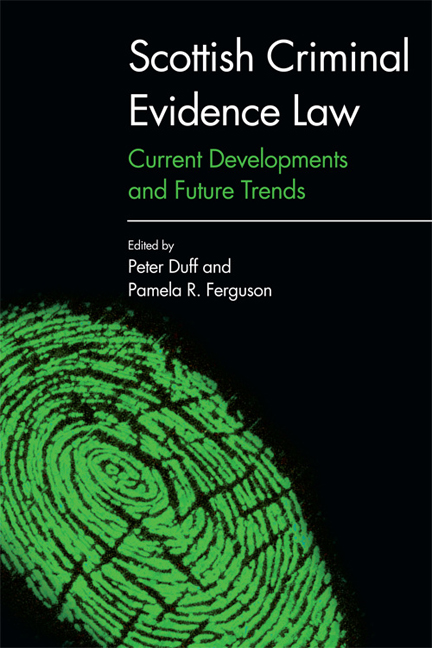Book contents
- Frontmatter
- Contents
- The Contributors
- Acknowledgements
- Table of Cases
- Table of Legislation
- Introduction
- 1 Cadder and Beyond: Suspects’ Rights and the Public Interest
- 2 ‘Access to Justice’ for Complainers? The Pitfalls of the Scottish Government’s Case to Abolish Corroboration
- 3 The Relevance of Sexual History and Vulnerability in the Prosecution of Sexual Offences
- 4 ‘Similar Fact’ Evidence and Moorov: Time For Rationalisation?
- 5 Hearsay in Scots law: Rethinking and Reforming
- 6 Eyewitness Identification Evidence and its Problems: Recommendations for Change
- 7 Assessing Witness Credibility and reliability: Engaging Experts and Disengaging Gage?
- 8 The process of Criminal Evidence Law Reform in Scotland: what Can We Learn?
- 9 Scottish Criminal Evidence Law Adrift?
- Bibliography
- Index
6 - Eyewitness Identification Evidence and its Problems: Recommendations for Change
Published online by Cambridge University Press: 24 April 2021
- Frontmatter
- Contents
- The Contributors
- Acknowledgements
- Table of Cases
- Table of Legislation
- Introduction
- 1 Cadder and Beyond: Suspects’ Rights and the Public Interest
- 2 ‘Access to Justice’ for Complainers? The Pitfalls of the Scottish Government’s Case to Abolish Corroboration
- 3 The Relevance of Sexual History and Vulnerability in the Prosecution of Sexual Offences
- 4 ‘Similar Fact’ Evidence and Moorov: Time For Rationalisation?
- 5 Hearsay in Scots law: Rethinking and Reforming
- 6 Eyewitness Identification Evidence and its Problems: Recommendations for Change
- 7 Assessing Witness Credibility and reliability: Engaging Experts and Disengaging Gage?
- 8 The process of Criminal Evidence Law Reform in Scotland: what Can We Learn?
- 9 Scottish Criminal Evidence Law Adrift?
- Bibliography
- Index
Summary
INTRODUCTION
Identification of the accused as the perpetrator of a crime has been the subject of many Scottish appeals. Where identification is a contested issue, the prosecution may establish that the accused and the perpetrator are synonymous by a variety of means, such as fingerprint or DNA evidence, voice recognition, or eyewitness identification. This chapter focuses on the last of these, since it is widely accepted that the most common cause of wrongful convictions is mistaken eyewitness identification. The chapter is in three parts: Part A describes the various forms of eyewitness identification procedures employed in Scotland; Part B considers the problems associated with this type of evidence and critiques the Scottish approach; and Part C argues that we need to reform our processes if we are to avoid wrongful convictions. It makes ten principal recommendations for change.
As explained in Cairns's earlier chapter, the Carloway Review of 2010 recommended that the corroboration requirement be abolished. The controversy this engendered caused the Scottish Government to establish an Independent Reference Group (the Post-Corroboration Safeguards Review), chaired by Lord Bonomy, to make further recommendations. His Lordship formed an Academic Expert Group (AEG) whose remit was to prepare a preliminary report for the Bonomy Committee on types of evidence which are notorious for causing miscarriages of justice. These included false or fabricated confessions; evidence given by accomplices and informers; hearsay evidence; and eyewitness misidentifications. As a member of the AEG, I was responsible for reporting on the last of these topics. The removal of the corroboration requirement could prove particularly problematic in respect of these forms of evidence. On the day on which Lord Bonomy's committee submitted its report, the Scottish Government announced that it would reconsider its decision regarding corroboration. This review process has revealed that our laws and procedures in relation to eyewitness identification evidence are in need of reform – and this is so, whatever the fate of the corroboration requirement.
A. SCOTTISH EYEWITNESS IDENTIFICATION PROCEDURES
(1) Pre-trial identification
A witness to a crime may point out the perpetrator to the police during or in the immediate aftermath of a crime. This so-called ‘street identification’ could be spontaneous, where the witness takes the initiative, or the police may show a suspect to a witness and ask whether or not the witness can confirm that this is the perpetrator.
- Type
- Chapter
- Information
- Scottish Criminal Evidence LawCurrent Developments and Future Trends, pp. 139 - 160Publisher: Edinburgh University PressPrint publication year: 2017



